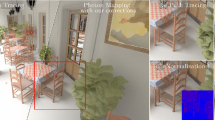Abstract
The photon map method allows efficient computation of global illumination in general scenes. Individual photon hits, generated using Monte Carlo particle tracing, are stored in the maps and form a geometry independent representation of the illumination. Two important issues with the photon map are memory requirements to store the photons and the question how many photons are needed for an accurate representation of illumination in a certain scene. In this paper we introduce a method to control the density of photon maps by storing photons selectively based on a local required density criterion. This reduces memory usage significantly since in unimportant or over-dense regions less photons are stored. Results for caustic photon maps and global photon maps representing full illumination show a decrease in number of photons of a factor of 2 to 5. The required density states how accurate the photon map should be at a certain location and determines how many photons are needed in total. We also derive such a criterion based on a novel path-importance-based first pass, taking some steps towards solving the difficult ‘how many photons’ question.
Access this chapter
Tax calculation will be finalised at checkout
Purchases are for personal use only
Preview
Unable to display preview. Download preview PDF.
Similar content being viewed by others
References
James R. Arvo. Backward Ray Tracing. In ACM SIGGRAPH ’86 Course Notes — Developments in Ray Tracing, volume 12, August 1986.
Philip Dutre and Yves D. Willems. Potential-Driven Monte Carlo Particle Tracing for Diffuse Environments with Adaptive Probability Density Functions. In P. M. Hanrahan and W. Purgathofer, editors, Rendering Techniques ’95, pages 306–315, New York, NY, 1995. Springer-Verlag.
Paul S. Heckbert. Adaptive radiosity textures for bidirectional ray tracing. Computer Graphics, 24(4): 145–154, August 1990.
Homan Igehy. Tracing ray differentials. Computer Graphics, 33(Annual Conference Series): 179–186, 1999.
Henrik Wann Jensen. Importance driven path tracing using the photon map. In P. M. Hanrahan and W. Purgathofer, editors, Rendering Techniques ’95, pages 326–335 326–335. Springer-Verlag, New York, 1995. also in Proceedings of the Sixth Eurographics Rendering Workshop, 1995 (Rendering Techniques ’95, Springer Verlag).
Henrik Wann Jensen. Global illumination using photon maps. In Xavier Pueyo and Peter Schröder, editors, Eurographics Rendering Workshop 1996, pages 21–30, New York City, NY, June 1996. Eurographics, Springer Wien. ISBN 3–211–82883–4.
Henrik Wann Jensen. Rendering caustics on non-lambertian surfaces. Computer Graphics Forum, 16(1):57–64, 1997. ISSN 0167–7055.
Henrik Wann Jensen. A practical guide to global illumination using photon maps. In ACM SIGGRAPH ’99 Course Notes — Unpublished, chapter 7, pages 1–72. 1999.
Henrik Wann Jensen and Niels Jørgen Christensen. Photon maps in bidirectional Monte Carlo ray tracing of complex objects. Computers and Graphics, 19(2):215–224, March-April 1995.
Henrik Wann Jensen and Per H. Christensen. Efficient simulation of light transport in scenes with participating media using photon maps. In Computer Graphics (ACM SIGGRAPH ’98 Proceedings), pages 311–320, 1998. r.
J. T. Kajiya. The rendering equation. In Computer Graphics (SIGGRAPH ’86 Proceedings), volume 20, pages 143–150, August 1986.
E. P. Lafortune and Y. D. Willems. A theoretical framework for physically based rendering. Computer Graphics Forum, 13(2):97–107, June 1994.
Dani Lischinski, Brian Smits, and Donald P. Greenberg. Bounds and Error Estimates for Radiosity. In Computer Graphics Proceedings, Annual Conference Series, 1994 (ACM SIGGRAPH ’94 Proceedings), pages 67–74, 1994.
S. N. Pattanaik and S. P. Mudur. Adjoint equations and random walks for illumination computation. ACM Transactions on Graphics, 14(1):77–102, January 1995.
Ingmar Peter and Georg Pietrek. Importance driven construction of photon maps. In G. Drettakis and N. Max, editors, Rendering Techniques ’98 (Proceedings of Eurographics Rendering Workshop ’98), pages 269–280, New York, NY, 1998. Springer Wien.
Peter Shirley. A ray tracing method for illumination calculation in diffuse specular scenes. In Proceedings of Graphics Interface ’90, pages 205–212, Toronto, Ontario, May 1990.
B.W. Silverman. Density Estimation for Statistics and Data Analysis. Chapmann and Hall, New York, NY, 1986.
Brian E. Smits, James R. Arvo, and David H. Salesin. An importance-driven radiosity algorithm. Computer Graphics, 26(2):273–282, July 1992.
F. Suykens and Y. D. Willems. Weighted multipass methods for global illumination. In Computer Graphics Forum (Proc. Eurographics ’99), volume 18, pages C-209-C-220, September 1999.
Eric Veach and Leonidas J. Guibas. Optimally Combining Sampling Techniques for Monte Carlo Rendering. In Computer Graphics Proceedings, Annual Conference Series, 1995 (ACM SIGGRAPH ’95 Proceedings), pages 419–28, 1995.
Gregory J. Ward, Francis M. Rubinstein, and Robert D. Clear. A Ray Tracing Solution for Diffuse Interreflection. In Computer Graphics (ACM SIGGRAPH ’88 Proceedings), volume 22, pages 85–92, August 1988.
Author information
Authors and Affiliations
Editor information
Editors and Affiliations
Rights and permissions
Copyright information
© 2000 Springer-Verlag Wien
About this paper
Cite this paper
Suykens, F., Willems, Y.D. (2000). Density Control for Photon Maps. In: Péroche, B., Rushmeier, H. (eds) Rendering Techniques 2000. EGSR 2000. Eurographics. Springer, Vienna. https://doi.org/10.1007/978-3-7091-6303-0_3
Download citation
DOI: https://doi.org/10.1007/978-3-7091-6303-0_3
Published:
Publisher Name: Springer, Vienna
Print ISBN: 978-3-211-83535-7
Online ISBN: 978-3-7091-6303-0
eBook Packages: Springer Book Archive




